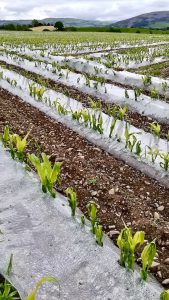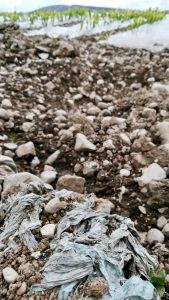There’s a miracle ingredient that can keep your potting compost going on and on… but it comes with an environmental price-tag.
This time last year, I was astounded by how well my greenhouse tomatoes were doing. Twelve months on, I’m truly gobsmacked at how well this year’s plants are faring.
My astonishment has nothing to do with the challenges of this spring’s topsy-turvy weather – it’s been all over the place here in recent months – but everything to do with what their roots are, once again, anchored in. However, my amazement is tempered by an awareness that I’m growing on the horns of a gardening dilemma.

In 2021 I grew a mixture of mostly blight- and mould-busting cordon varieties, which cropped their heavy socks off right into dank October, grown in the previous year’s peat-free compost. This had sat in pots through the winter, until I knocked it out, broke up any lumps and fished out the remains of the previous summer’s tomatoes. I gambled on using it again by reinvigorating it using ‘digestate’, which I’ve been experimenting with over the last few years with eye-opening results.
I wasn’t disappointed; last summer’s strong, healthy plants grew like billy-oh. Apart from a sporadic watering with dilute seaweed extract, I didn’t bother with regular feeding. There was no need.
Digestate is the fibrous, chopped-up remains of forage maize (grown for its ‘biomass’ rather than the sweet cobs we’re familiar with) and other grasses, which is fed to bacteria in anaerobic digesters. The resultant methane ‘biogas’ is either fed into the domestic gas supply or burnt to generate ‘green’ electricity. Digestate derived solely from plant material (some digesters take mixed food waste) is inherently vegan-friendly.

The maize and other feedstock that goes into digesters (they need a steady, consistent flow of material to work efficiently) is inevitably grown as a vast monoculture; some of those stretching-to-the-horizon fields of ‘sweetcorn’ we travel past in rural areas during summer are destined for digesters, others for livestock feed. Maize is an annual, frost-tender plant, so it has to be sown from scratch each spring.
Once it’s harvested, the soil is often left bare, and prone to damage and erosion; heavy and extreme bouts of rainfall wash it into our streams and rivers, polluting them. Liquid digestate leaks can also harm already beleaguered aquatic ecosystems. Savvier farmers use low-tillage and overwintering cover crops (living green manures), and regular crop rotations, to protect and enrich their soil. Unfortunately, some don’t.
So when we buy digestate-derived gardening products – even if they’re from a well-run, soil-savvy and transparent source – we are, by parting with our green gardening pound, ultimately helping to foster a farming system that banishes biodiversity from vast areas of land (forage maize and other grasses don’t excite pollinators or other wildlife). A boon for our gardens is helping to boost monotony in our countryside. It’s a garden-sown quandary.
But digestate (and its fetid liquid feed sibling) is packed with multiple plant nutrients (which are not lost during bacterial methane production) and, as I’m still discovering, it possesses almost alchemical qualities; mixing it 50:50 with mature leaf mould results in an all-purpose peat-free mix that needs nothing else adding – or any subsequent feeding. And seen in ‘footprinting’ terms, blending digestate from a distant source with your own super-local leaf mould – from leaves that fell in or near your own garden – is effectively slicing your potting compost’s footprint in half.

Another upside to using plant-derived digestate is that, unlike so much green waste compost (made from the contents of ‘garden waste’ bins that are routinely contaminated by human detritus), it is essentially free of bits of plastic and other potential soil pollutants. As we steer laggardly toward a 100% peat-free future, this alone wins digestate brownie points.
Last summer I vowed to see just how long I could keep on revitalising the same tomato-growing compost, so this spring I’ve followed the same simple, successful recipe: mixing two-thirds old – and what ought to be clapped-out and flagging – compost with one-third digestate (a 50-litre bag of Bloomin Amazing), plus a bucketful of vintage leaf mould to microbially jump-start the mix… and nothing else.
So far the results, again, are astonishingly alchemic: plants growing in compost that is now in its third tomato-growing season are flying. I doubt any top-quality brand of peat-free compost could produce plants as good (it’s no surprise that there are now peat-free, vegan-friendly and organically certified composts made with digestate that are gaining solid plaudits). Bar root-disease outbreaks, year four here I come, magic digestate at the ready – despite some niggling doubts about its origins.

A spring visit to Cumbria did, briefly, turn niggles into fears. In late May, much of the arable farmland in the south of the county was covered in shiny strips of clear plastic, through which some kind of tall crop was pushing. These mulches are commonly used to improve the germination, and advance the growth, of crops such as carrots and lettuce – they were once sold to gardeners – but this crop was unfamiliar.
When I finally got in close, my heart sank: the sickly-yellow plants pushing impatiently through the plastic film were maize. Getting even closer, I found the tattered remnants of discarded plastic mulches buried in, and littering, the soil (some are technically ‘biodegradable’). I also found shiny streamers in the hedges. The lapwings crying above the plastic-wrapped field said it all.
In the following days I didn’t spot the familiar, rounded dome of a single anaerobic digester, and eventually the pervasive, foul stench of farm slurry splattering the fields told me why: maize is grown here primarily for silage that’s used to feed animals, not bacteria. This far north, plastic mulch is essential to ensure maize germinates and then survives cold snaps. Fears faded back to lingering doubts; this wasn’t digestate country. At least not for now.
So I’m sitting easy with digestate – while keeping doubts close by. Digestate has much to offer planet-enriching gardeners. If it can reboot my old potting compost, meaning that it goes on and on and on, I’m going to rub along with it – for now.
Text and images © John Walker.
Find John on Twitter @earthFgardener


